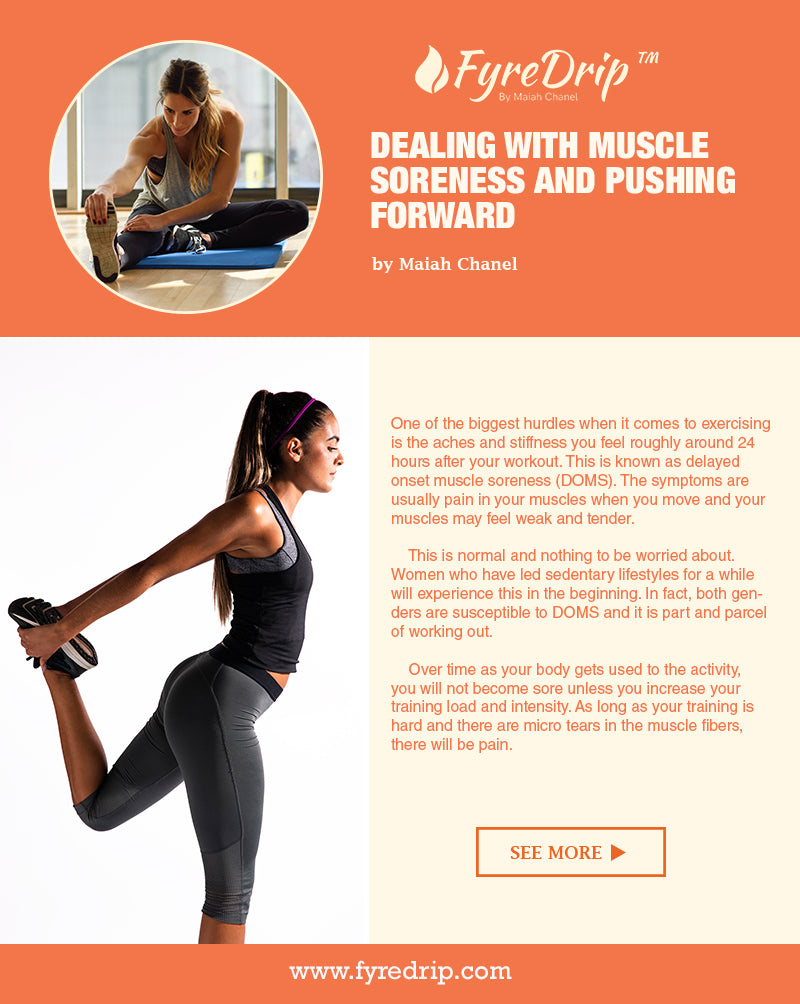
Dealing with Muscle Soreness and Pushing Forward
Share
One of the biggest hurdles when it comes to exercising is the aches and stiffness you feel roughly around 24 hours after your workout. This is known as delayed onset muscle soreness (DOMS). The symptoms are usually pain in your muscles when you move and your muscles may feel weak and tender.
This is normal and nothing to be worried about. Women who have led sedentary lifestyles for a while will experience this in the beginning. In fact, both genders are susceptible to DOMS and it is part and parcel of working out.
Over time as your body gets used to the activity, you will not become sore unless you increase your training load and intensity. As long as your training is hard and there are micro tears in the muscle fibers, there will be pain.
You must be able to distinguish the difference between muscle soreness from cramps or muscle strains and pulls. DOMS is just discomfort that arises from inflamed muscles that are healing. Your body will not be in pain if you’re not moving. Muscle soreness is felt only when you move.
Cramps, however, are sudden pain spasms that arise due to a contraction of muscle fibers. The best way to treat cramps is to stretch the muscle. Massaging and stretching a cramped muscle will ease the pain.
The same does not apply to muscle soreness. Stretching before workouts, muscle rub creams, massages, ice baths, etc. cannot prevent muscle soreness. They may provide temporary relief but you will still need 2 to 4 days for your muscles to heal.
It can be discouraging in the beginning when you embark on a training program and plan to exercise regularly but after one workout, you can’t move without groaning for a few days. You’ll need to rest till you’re healed.
The best way to prevent this is to make your first few sessions light. The goal is to just do a few of the exercises and use light weights. If it’s cardio, don’t go all out and give your maximum effort. Just stick to a slow or moderate pace.
Even short 15 or 20 minute sessions will suffice in the beginning. This will prevent your muscles from being too sore the next day. Always ease into your training regimen slowly. By slowly and gradually increasing your intensity and training load, you’ll be giving your body time to adapt to the demands placed upon it.
Many women are eager to lose the weight fast or get fit overnight and they try to give it their best. Common fitness mantras like ‘Go hard or go home’ and ‘No pain no gain’ do not help here.
These motivational quotes are best used by athletes and people who train often. When you’re just starting off, do go slow. Slow progress is better than no progress.
In the event that you still have muscle soreness, you can try soaking in a tub of water with Epsom salts or you can try over-the-counter muscle rubs. These will provide temporary relief.
If you’re experiencing muscle soreness in your legs, you can always focus the day’s workout on your upper body and vice-versa. There’s no need to skip a workout if just one part of your body aches. You’ll feel satisfied knowing that you at least got something done for the day.
However, if your entire body aches and this can occur when you do full-body workouts, you can rest or go for a slow walk. Resting and recovery is just as important as activity. It doesn’t mean you’re off track. Even a tiger crouches before it leaps.
So, don’t feel dejected and quit just because your first few sessions are causing you pain. Maintain a positive mindset and keep pushing forward knowing that pain is weakness leaving the body. Approach your training in a gradually progressive manner and you’ll be just fine.
Stay FYRE!?
Maiah Chanel
